Your cart is currently empty!

Dog Training Tips for Children
Having a dog is a great way to get outside, stay active, and learn about loyalty and companionship. Training a dog for basic obedience and to play games can improve the relationship between a dog and a child. However, with everything that goes along with getting a puppy or an older dog, it’s hard to know where to start and what to do when it comes to training. Our Creative Team member and Illinois mom of two, Meghan Garriott, took her son along on a fun-filled morning with a dog training family. They learned some great tips and tricks and even found some unexpected benefits that came along with the training process. Read along to learn the best ways to get children involved in the dog training process.
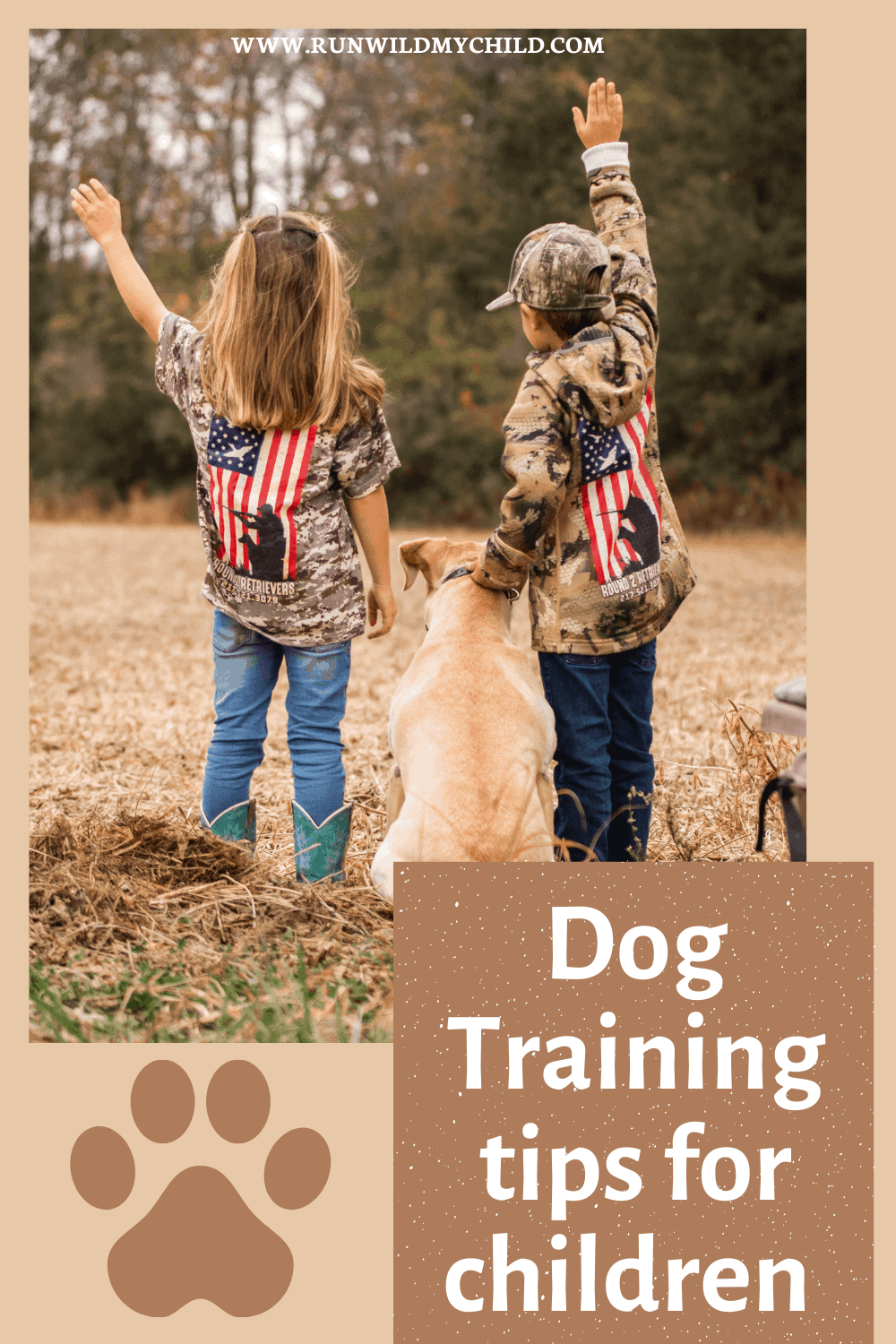
A dog training family
My son Emmett (5), and I spent a morning outside, learning all the ends and outs of dog training with the Houk family, Avery (5) and her parents, Justine and T.W. The Houk’s run Round 2 Retrievers in Bethany, Illinois, where they train dogs for hunting, hunt testing, obedience, and puppy preschool. Avery spends most of her days, when not in school, outside training alongside her dad, or inside getting dogs socialized. Her confidence and control when handling the dogs can be recognized immediately and is amazing to watch.
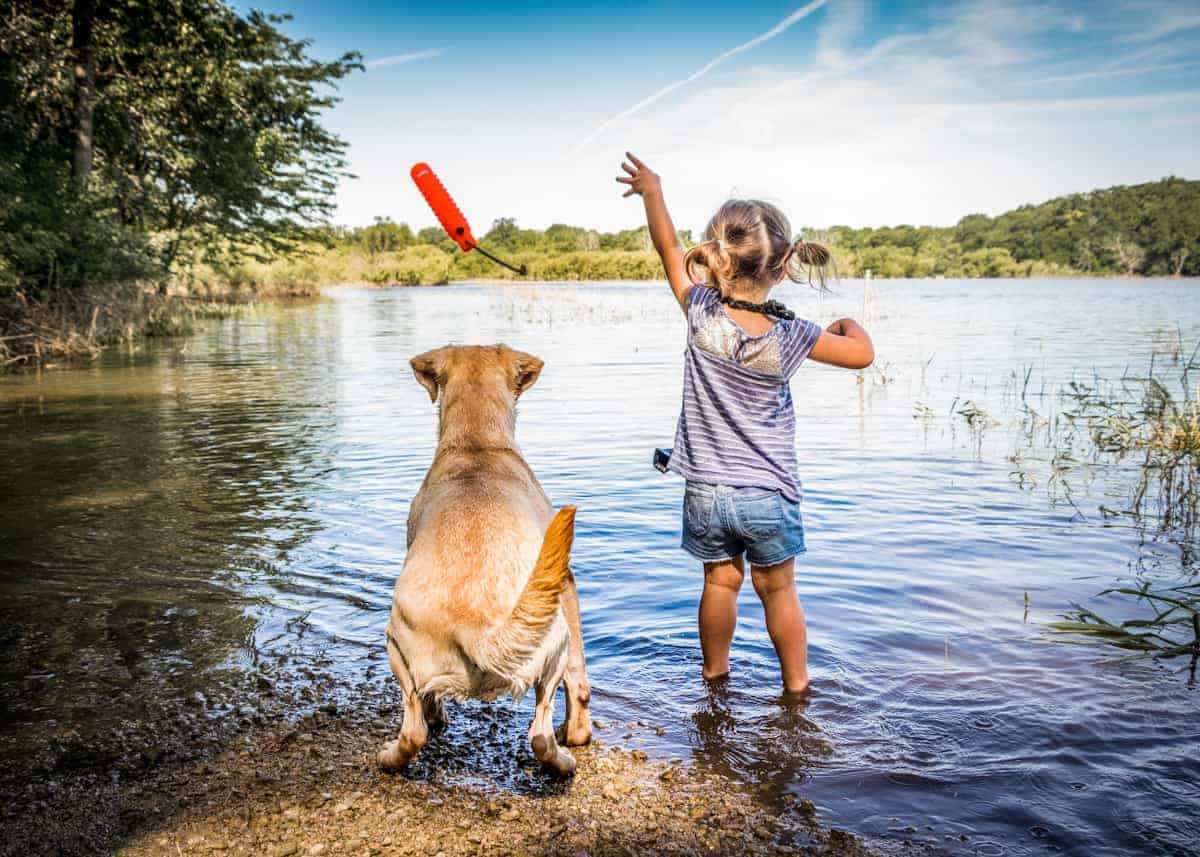
Setting up the training session
Our morning started with setting up the training activities. The kids helped TW by bringing bumpers to the tree line, which was approximately 160 yards away. These bumpers are for the dogs find later in the training. Bumpers are durable plastic dummies that the dogs can carry in their mouths. When training for hunting the bumpers are used in place of what the animal is trained to retrieve for the hunter (e.g. ducks and other birds).
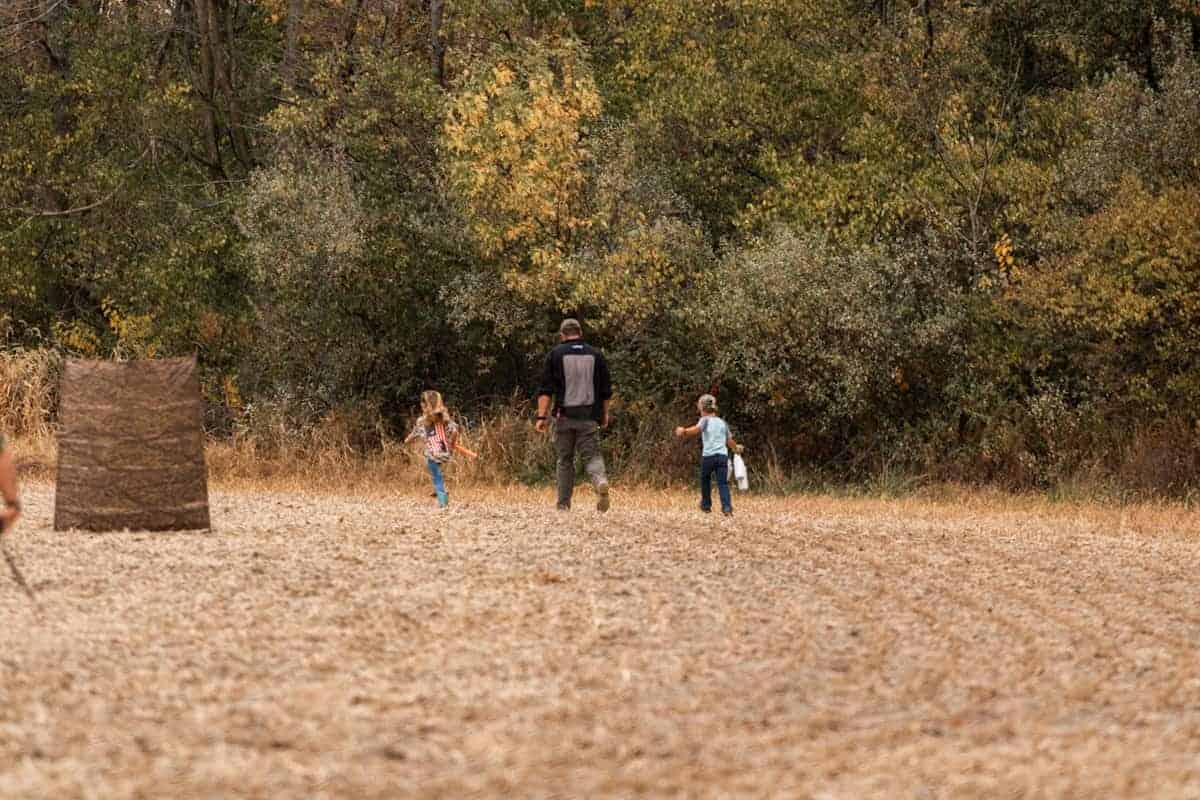
Taking to the training field
The first dog to take to the training field was an advanced black lab named Stoger. We watched as Stoger was released from the sitting position by use of his name. With ease, Stoger was guided with hand signals and whistleblows to where the bumpers were.
T.W. signaled right or left with hand signals and called “back in” or “to attention” with whistleblows. Because of the uneven terrain, the dogs can’t see the bumpers until they are within a few feet of them. The dogs must rely on the hand signals and the whistle blows in order to get them to the right place to find the prize.
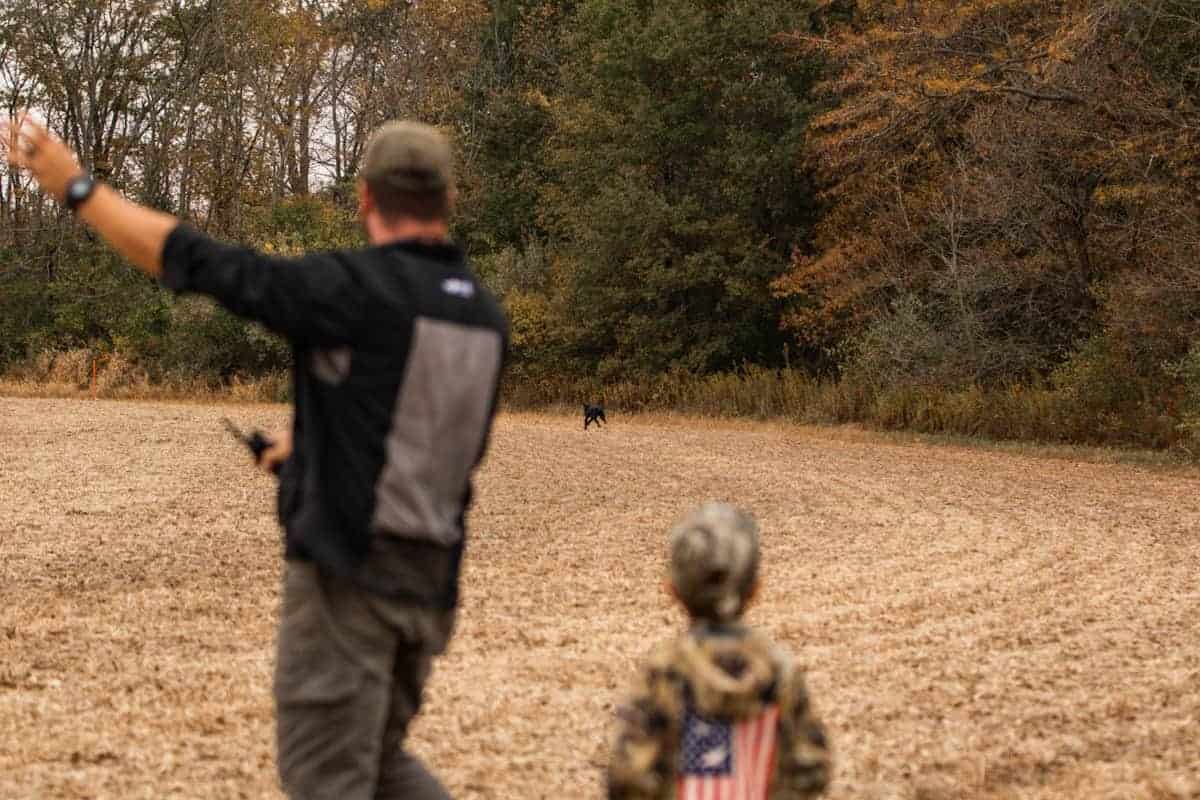
Age of dog for training
We met a large variety of dog breeds and dogs of various ages while visiting Round 2 Retrievers. Some of these dogs were in various stages of hunt training, while others were there just for obedience training. T.W. says dogs can begin any type of training as young as 8 weeks. And while you can certainly teach an old dog new tricks, it is easier when you start with simple commands from a young age. It is easier to train a dog to properly do tasks than to have to correct old habits first.

Puppy training
With puppies, it is helpful to get them used to a collar and a leash early on. This is a great task for children to get involved with from the beginning. One of the younger dogs we observed that was being trained wore a long rope leash. The leash was not used to direct the dog anywhere (verbal commands and hand signals were used for that). The leash was there so he could get used to it and as a safety precaution in case they needed to use it.
T.W. says it is important for a puppy to be properly socialized and get them used to being touched in order to prevent future problems, especially around children. To do this, he suggests often touching their paws, opening their mouths to look at their teeth, rubbing their bellies, and lifting and checking their ears. This makes the dog more comfortable being touched by their owners, groomers, and veterinary staff in the future.

Beginner-level dog training
The first commands to learn when beginning dog training are: “sit,” “here,” and “heel.” T.W. says that when dogs that come to them already knowing these commands, they’re way ahead and are much easier to progress than dogs starting from scratch. The best way to implement these commands is to have the dog sit before completing activities like going outside and before being given food.
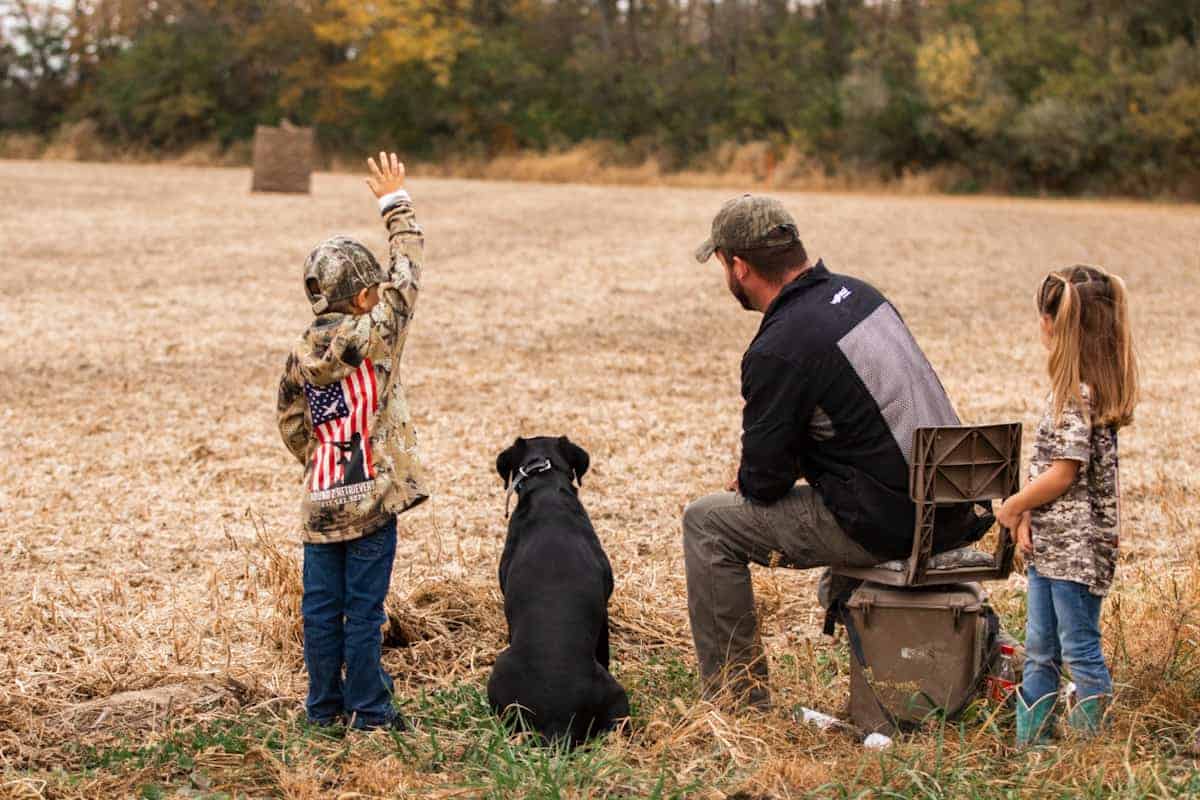
Kids can help with dog training from the start
For children involved in the training process, sit, heel, and stay are easy words to say and can be done many times throughout the day. Early commands teach the dog to be alert for commands. “Sit” can be easily carried out by gently pushing their bottom to the floor to show them what you mean when you say sit. Do this every time to reinforce the command/action connection until the dog does it automatically. These first commands should be given along with a hand signal. As the dog advances, the verbal command can be dropped, and just hand signals can be given (or vice versa depending on the circumstances).
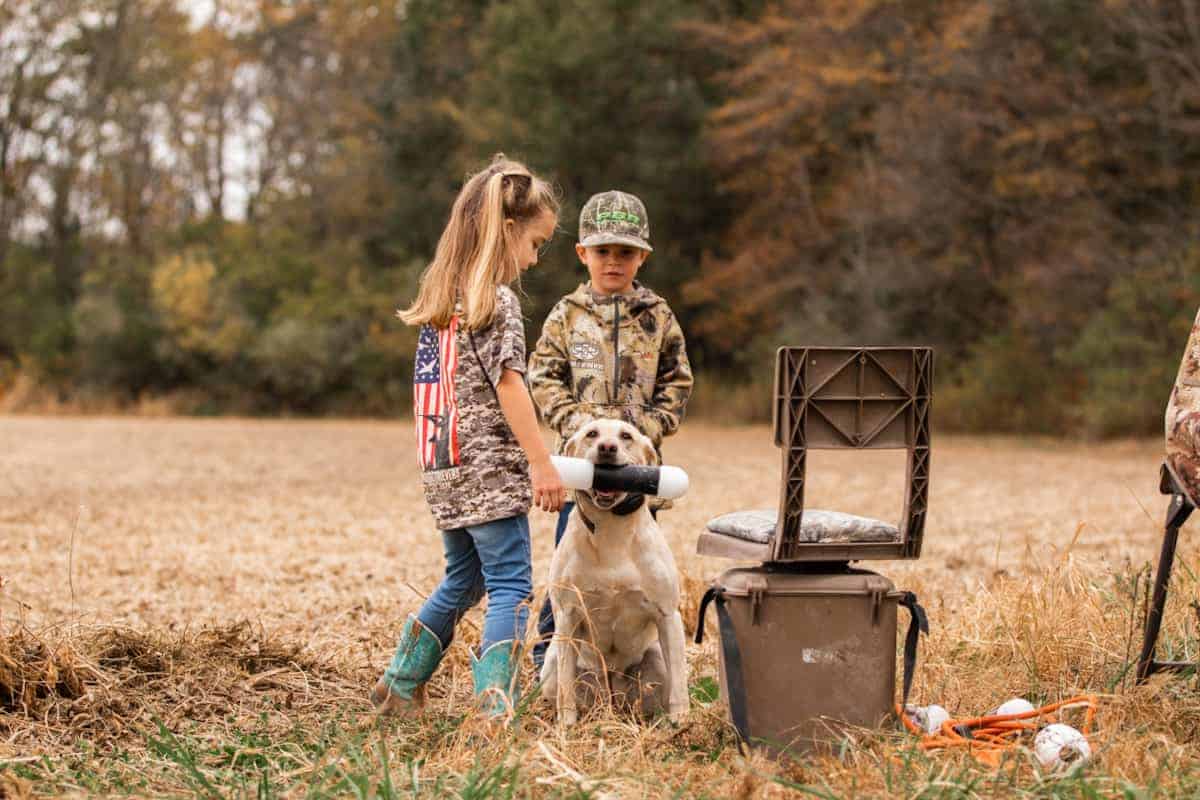
Consistency is key
T.W. notes that the amount of time training each day does not have to be great, especially in the beginning. Consistency is what matters most. A lot of time does not need to be spent giving or carrying out the commands, but they should be done frequently and in different situations for the dog to learn. Be sure to give the same word and hand signal every time so that dog is not confused and knows what to expect.
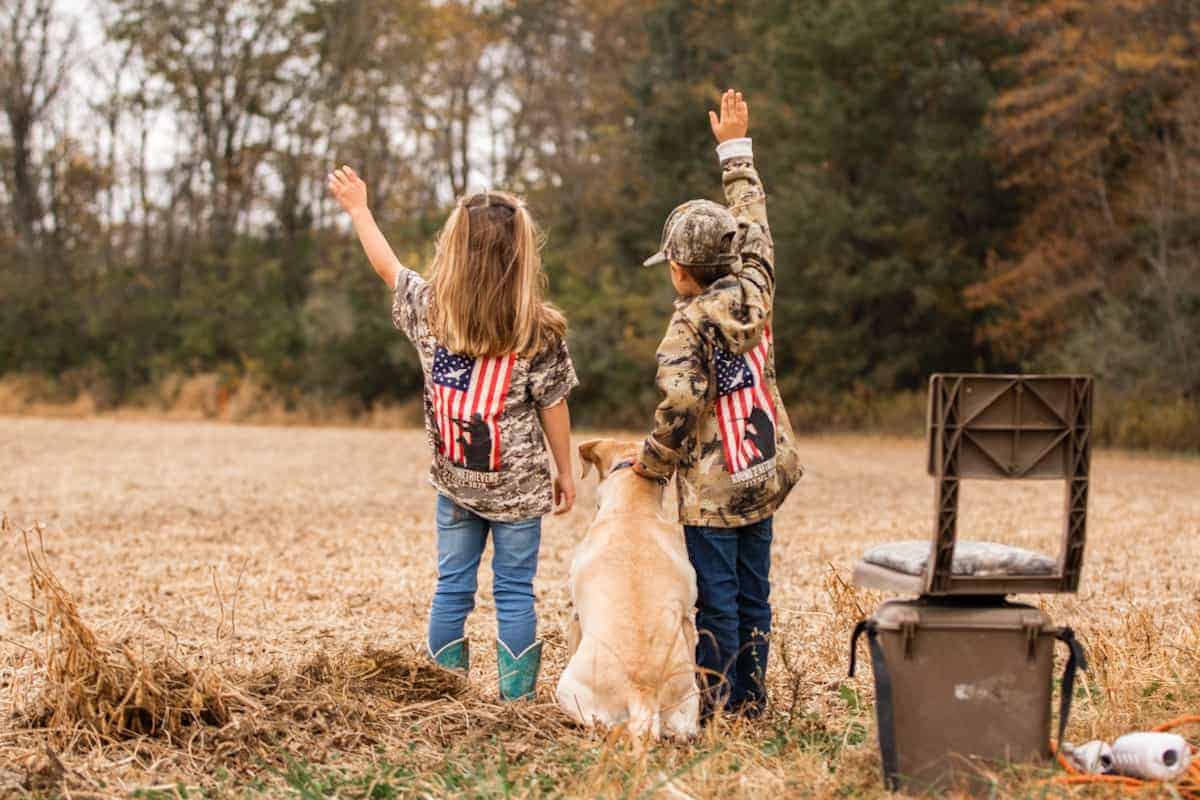
Training techniques
There are many different techniques used to train dogs: (1) positive reinforcement with rewards such as treats or affection, (2) e-training with an electrical shock collar to alert or discourage the dog, (3) attrition, which is a technique of repeating a command until the dog gets it right, while also actively preventing the wrong action. With this technique, you don’t punish wrong behavior; you merely prevent it. At Round 2 Retrievers, Avery and T.W. use a combination of these techniques. For younger dogs or dogs just beginning their training, attrition is mainly used along with rewarding with affection.
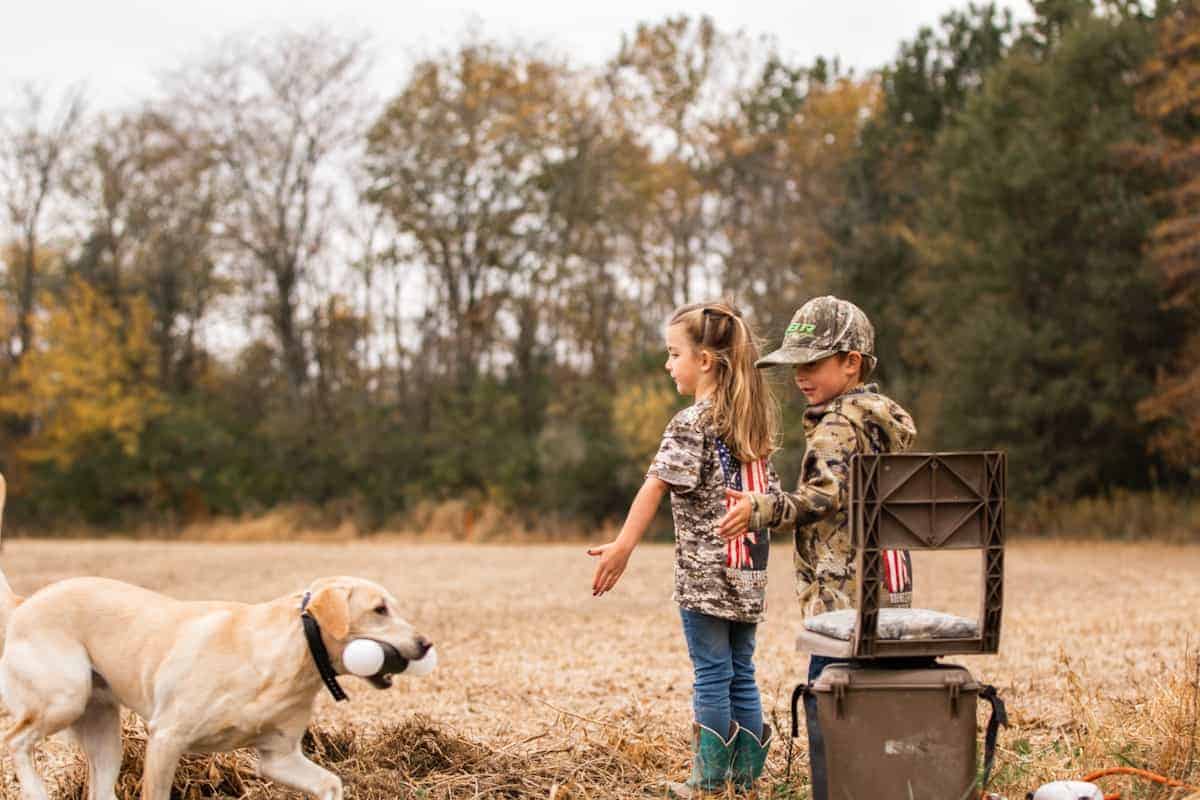
Children excel at affection
A child’s love and affection are the best rewards for most dogs. Children give this affection easily. This easy affection was clearly observed as Avery and Emmett interacted with the dogs, petting them, scratching their ears, and talking sweetly to them. Loyalty and the drive to please are some of the dogs’ greatest traits and they should be utilized and embraced when training. Likewise, the ease with which children give praise and their love of free play should also be embraced when going through the training process.
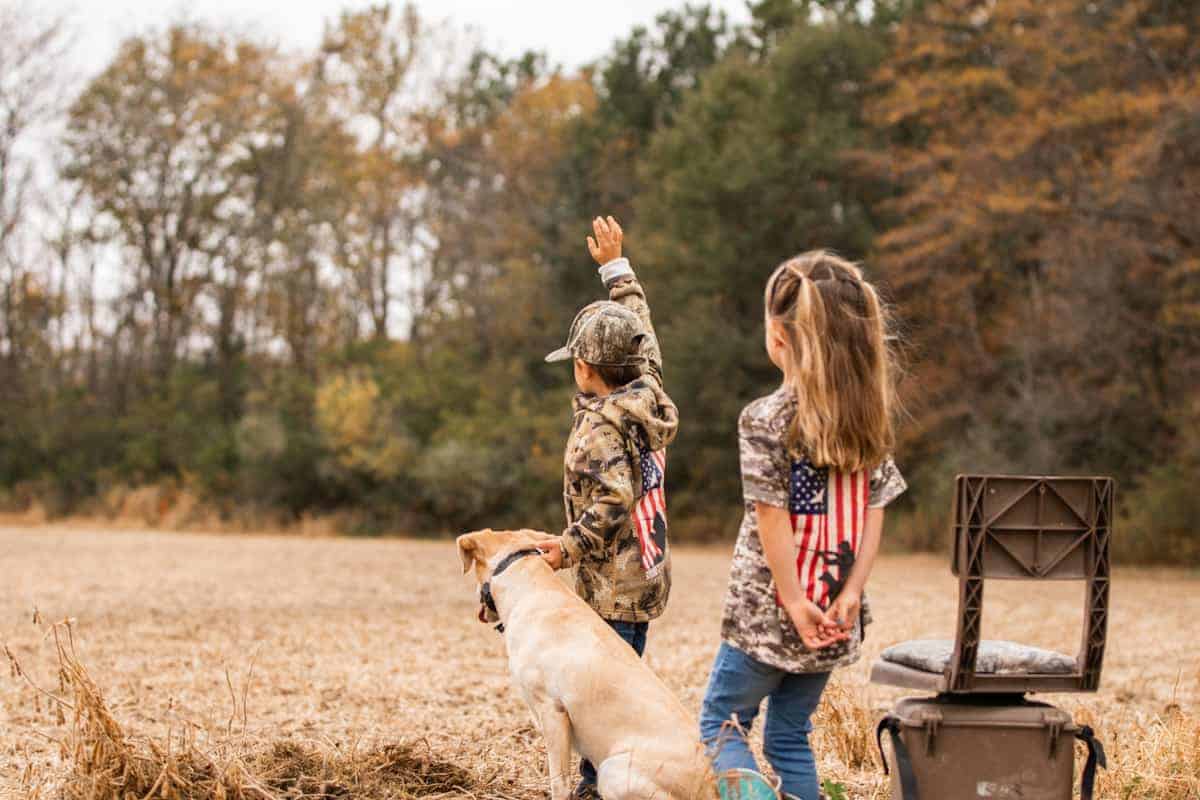
Dog breeds
When it comes to dog breeds, T.W. says most dog breeds can be trained to do most things. However, different breeds may have different motivators and may excel at particular activities. Active breeds, such as labs, retrievers, and shepherds like to move, play, and complete tasks. They are easily motivated with affection and praise for a job well done. More sedentary breeds (like Saint Bernards or bulldogs) may be more motivated by foot or treats.
If addressing general obedience or training the family dog to play games, all breeds are equally appropriate. For higher-level training like hunting dogs, working dogs, or service dogs, there are preferred breeds to suit the needs of those roles.
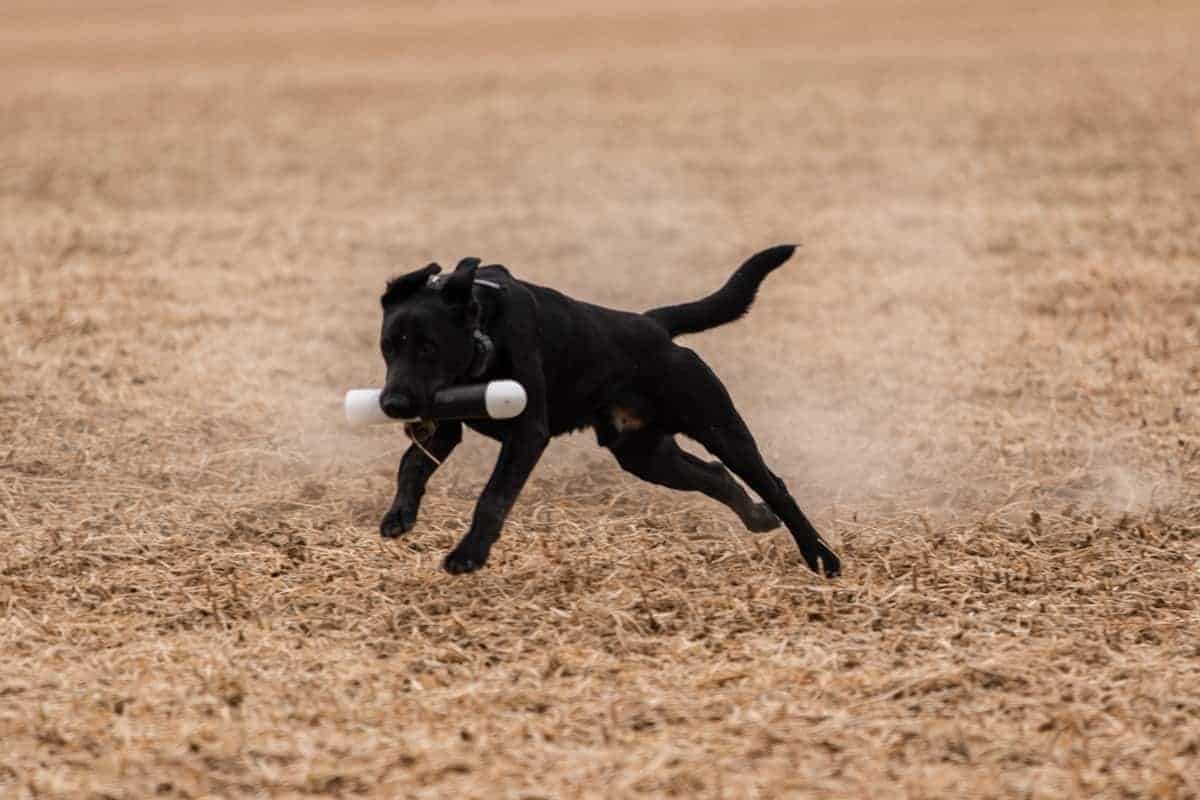
Safety while training
It is important to remember (and remind children) that dogs are animals and not people. As lovable and cute as they are, they still have protective instincts, and there are measures that should be taken to ensure children are safe around the dogs and vice versa.
T.W. says that most dog bite incidents happen around a dog’s kennel or around food. Be sure to educate children not to put their hands in a kennel, which is supposed to be a dog’s safe place. Children should also be instructed not to play or bother a dog while it is eating. When approaching a new dog or a dog that is not your own, do not approach them from behind, which may surprise them, and always ask the owner’s permission first before petting or approaching.
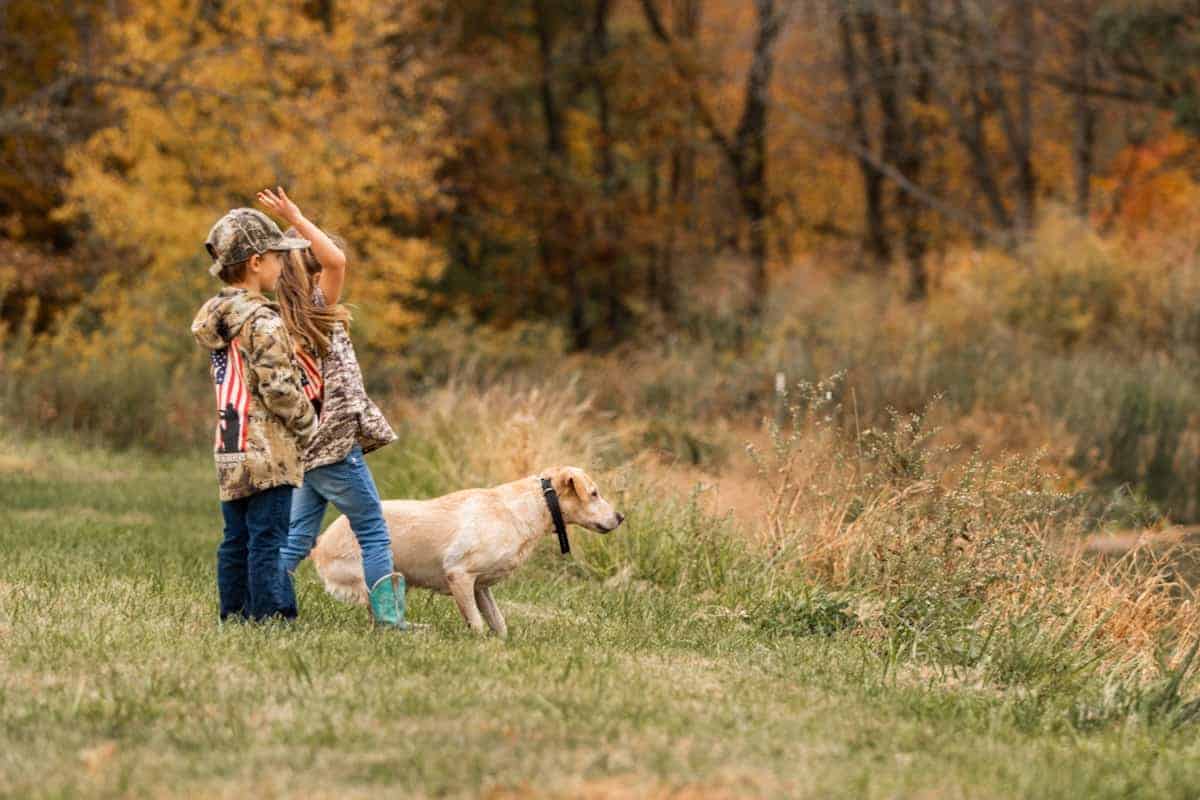
Dog training games for home
After seeing the hunting dogs train, we went up to the house and met a 9-month-old golden retriever named Lola. Lola was at Round 2 Retrievers for obedience training, but T.W. and Avery had also taught her a fun trick of finding his keys. T.W. said he started with a metal washer. He would put the metal washer on the ground with a treat in the middle and release her to find it. Once she got good at that, he stopped putting the treat in the middle and just placed the washer on the ground for her to find.
As she did well with that, he progressed her to keys. We watched as we were in the kitchen of the house, and T.W. threw his keys into the living room. He told Lola to find them, and off she went. She put her nose down on the keys till he came to retrieve them. This is an easy hide-and-seek game children can play with their dog at home. Plus, it can usefun as well when you need to leave and can’t find your keys!
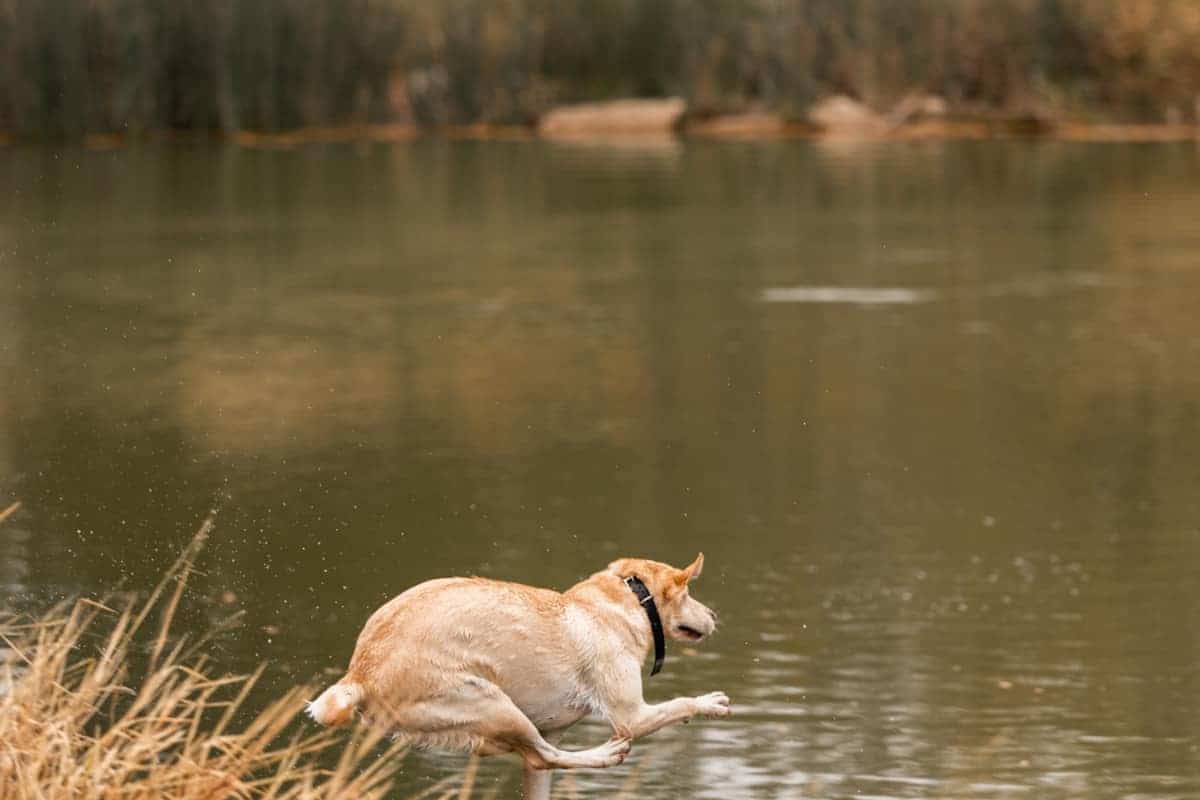
Outdoor games for kids and dogs
Dogs and children alike love to be outdoors and play games. Training dogs to play active games is a great way for the whole family to spend enjoyable time outdoors with their pet. Playing fetch with balls and frisbees is one of the better-known and easiest games to play.
Teaching the dog to drop the ball when commanded, or having the dog sit before giving a command to retrieve a thrown ball are ways to advance these games. Agility games, such as having dogs jump through hula hoops or over hurdles, can be great exercise and lots of fun for the dogs and kids. Hide and seek, as mentioned above, can also provide endless hours of fun.
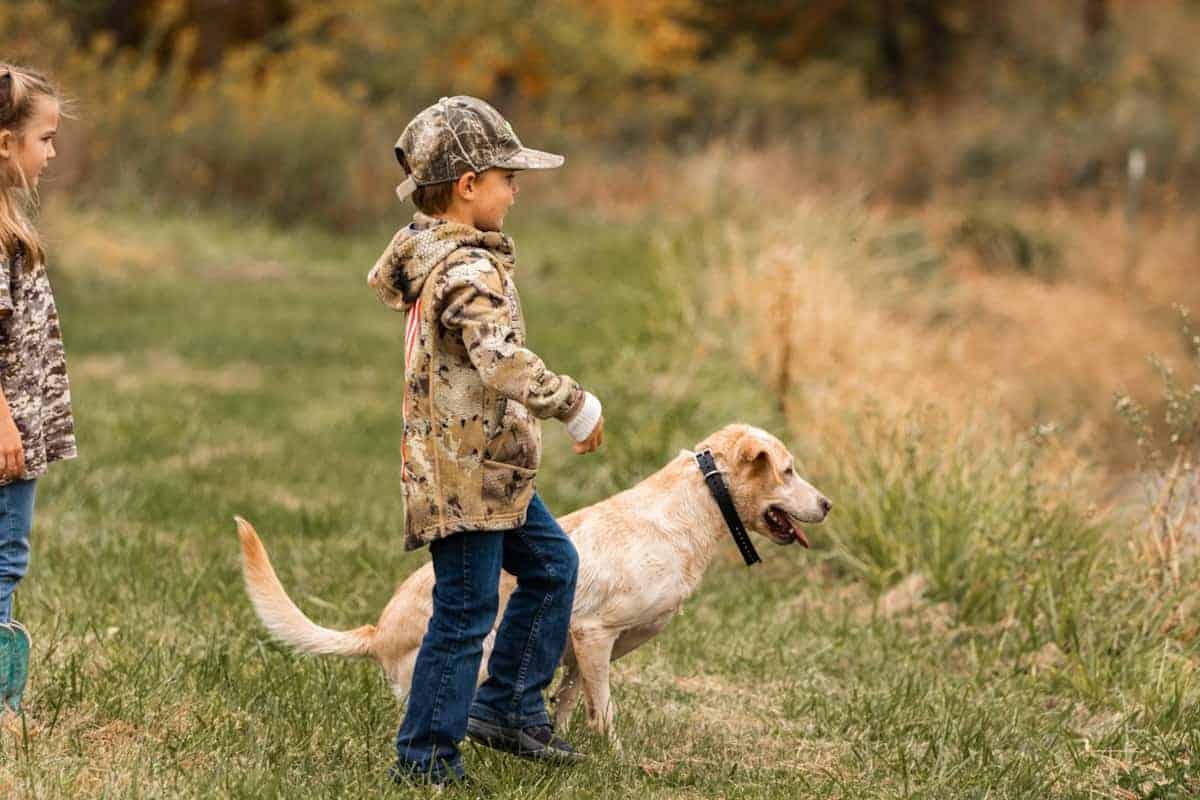
Unexpected confidence boost
Going to our training session, I thought I knew all the benefits of training and the process of training. The dog would be well-behaved (obviously), and playing outside with our dogs is something we could all do together. But as our session progressed, I became aware of another unexpected benefit. As Avery showed us how she took command of her dog Yeti, she was so confident in her commands. She had no trouble explaining to Emmett what to do and how to do it. She was calm and decisive and assured.
Emmett was at first very timid. We have dogs at home and Emmett wasn’t scared of the dogs. But he was lacking confidence in his ability to command Yeti and for Yeti to listen to him. With a quiet voice and his hands in his pockets, he started out very timidly. After a few tries with Avery by his side, he soon realized that Yeti would release when he so much as whispered “Yeti” and she would bring that bumper right to his hand if he held it out.
As the training progressed, his hands came out of his pockets. His voice grew louder and more confident. In just the short time we were there, not only did he learn a new skill, but his confidence in himself and his abilities grew tremendously. By the end of the morning, he was confidently throwing the bumper into the pond and was overjoyed to watch Yeti retrieve it. Seeing that confidence bloom in your child is a beautiful sight.
Check out our full post on all the benefits of raising kids around pets and animals.
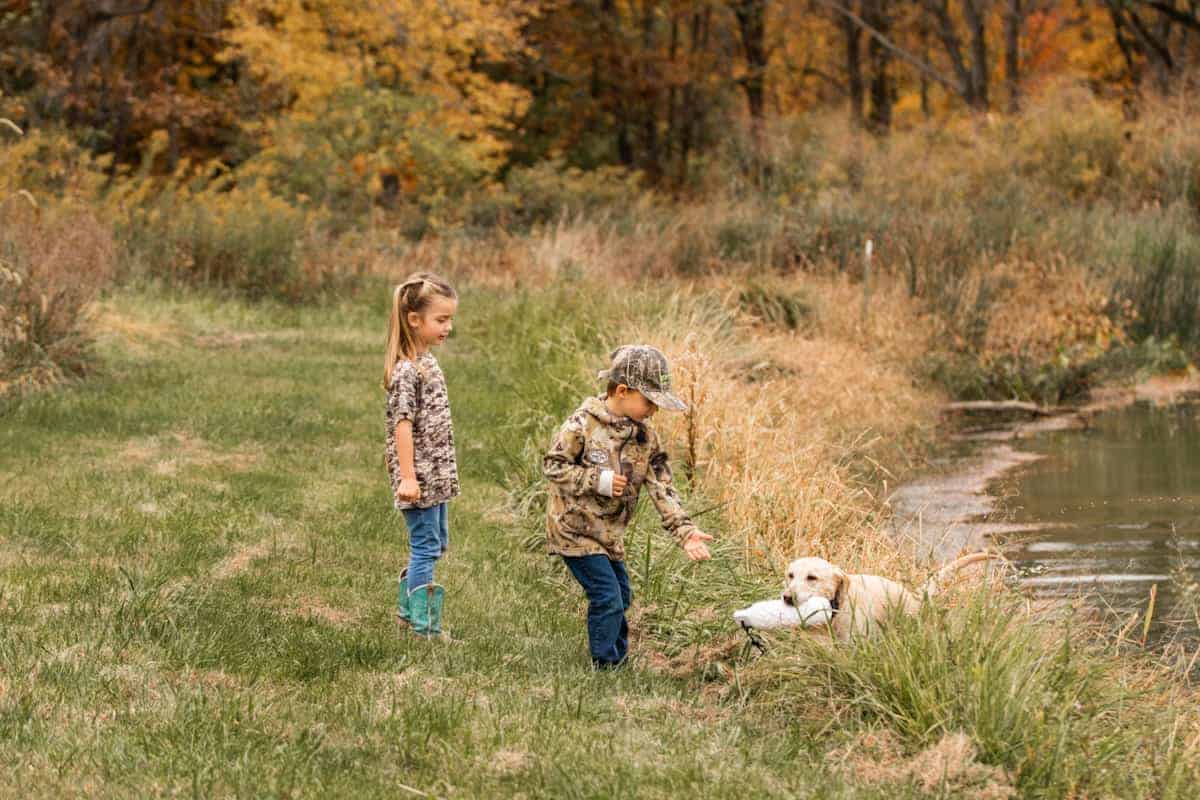
Benefits of training with children
Having a well-trained and obedient dog has obvious benefits. The dog is better behaved, listens better, and will be safer around children and in other situations. The process of training may seem difficult and time-consuming at first, but the benefits are immense and last a lifetime. Plus, when the whole family is involved in training, it can help build relationships and improve communication skills with each other and with the dog.
Training a dog takes consistency, patience, and grace. But, the relationship your family will build with your dog (and companion for many years) will be worth it. Plus, training your dog to play games can help get everyone outside and more active, improving the physical health of the entire family. Just remember to start small and have fun!
What will you and your dog start learning today?
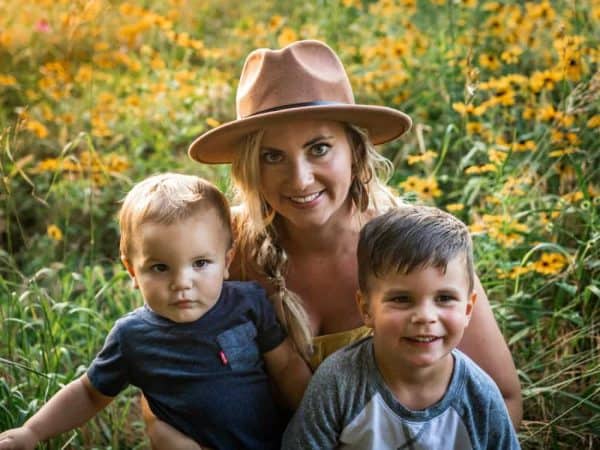
About the author
Meghan is a country living, mom of 2 boys in rural central Illinois. She is a Physical Therapist Assistant by trade but spends most of her time outside with her family. At home, she has large flower, herb, and vegetable gardens to tend and 3 large dogs to play with. As a family, they enjoy hiking, camping, boating, fishing, and helping her in-laws show and raise livestock. Photography became a hobby while in isolation after her oldest son’s bone marrow transplant. It has since become a passion to capture her family’s daily life. Throughout her family’s journey with rare disease and transplant, the outdoors have been a safe space for the whole family to grow, learn, and thrive.
You can find more from Meghan online in the following locations:
Instagram: @meghangarriott
RWMC posts: Meghan Garriott

Leave a Reply